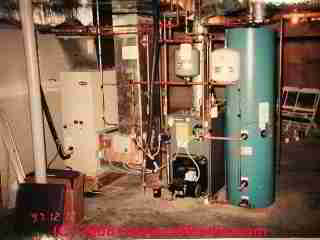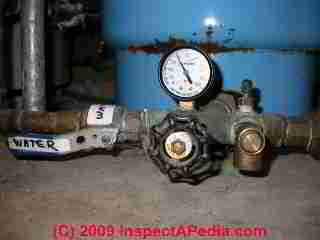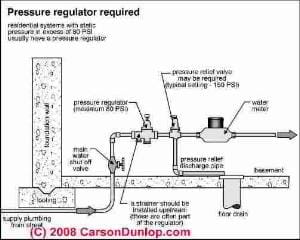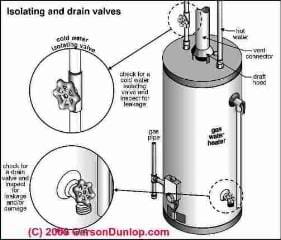 How to Turn Off the Building Water Supply System
How to Turn Off the Building Water Supply System
Avoid Freeze Damage
when Winterizing a Building
- POST a QUESTION or COMMENT about how & where to turn off all or some water supply to a building to avoid freeze damage
Building freeze protection guide to turning water off:
This article explains how and where to turn off the water supply to a building as part of winterizing or freezeproofing the structure. We discuss the decision to turn off water at a building, where to turn off water for both well water systems & municipal water supply.
We also describe handling the problem of turning off water at a building served by a steam boiler or hot water heating boiler - systems that must be guaranteed a water supply.
The articles at this series will answer most questions about freeze protection for piping and other building plumbing and heating system components: how to winterize a building to avoid frozen pipes, and how to thaw frozen water supply & drain piping, wells, & water tanks.
InspectAPedia tolerates no conflicts of interest. We have no relationship with advertisers, products, or services discussed at this website.
Guide to Turning off Water to a Winterized Building
[Click to enlarge any image]
A building owner who is unfamiliar with the plumbing and heating equipment in their building may be understandably intimidated by the maze of pipes, valves, switches, and controls such as those shown at the top of this page. Sketch above courtesy of Carson Dunlop Associates, a Toronto home inspection, education & report writing tool company [ carsondunlop.com ].
While there are building winterizing professionals who will be glad to come by to help protect your building from freeze damage and related water leak damage (when the frozen burst pipes and fixtures thaw out), it's pretty easy to understand what's needed.
Is the building heat going to be left "on" or "off" - the answer determines the extent of freeze-proofing needed.
The procedures we discuss in this article series address both "heat on" and "heat off " building shut-down procedures that are useful both in freezing climates and in warmer locales. In short, are two building & mechanical system general approaches depending on whether you're leaving the heat on or off:
- If heat is to be left on in a partially winterized building see the procedure
at: WINTERIZE - HEAT ON PROCEDURE (after reading the article below) - If heat is to be turned off and the building completely winterized, see the procedure
at: WINTERIZE - HEAT OFF PROCEDURE
Guide to Deciding to Turn Off All or Just Some Water Supply Valves
Turning off the water supply to a winterized building is the single most significant step that can be taken to protect the building from water damage due to frozen pipes.
Watch out: In an unattended building water from a burst hot water heating pipe or water supply pipe can run continuously for weeks or even months, causing major damage.
If the building main water valve has been closed (shut-off), even if a pipe should freeze and burst, the volume of water that spills into the building will be minimal in comparison with the terrible flooding that occurs if a pipe bursts, the water supply has been left "on" and no one is attending the building. You can usually find the main water shutoff valve just above the building floor where the water pipe enters the building.
When is it OK to turn off the water in a winterized building: If the building is heated by a warm air furnace or by electric heat, that is, by a heating system that does not require water (such as a hydronic boiler or a steam boiler), you can usually turn off the building water supply with no problem.
When is it Not OK to turn off water in a winterized building: But if the building is heated by a system that requires water, such as a steam boiler or a hot water (hydronic) heating boiler, turning off the building water supply can risk serious damage or total destruction to the heating boiler or even unsafe conditions.
That's because most heating systems that use water rely on the presence of an automatic water feed valve to assure that makeup water is sent into the heating boiler whenever its water level drops below a safe level.
What can we do to protect a building from frozen burst pipes and later flooding if heat is provided by a hot water heating system?
- Go ahead and turn off the water: some hydronic heating boilers do not normally consume water; on occasion we see that the building winterizing procedure has included simply "taking a chance" and turning off the water. See WHERE TO TURN OFF the Building Water Supply, in this article, found just below.
If you know the boiler's behavior well and know that there are no leaks in the hot water heating system you might feel that the risk of boiler damage due to running out of water is low.
Of course should a leak in the heating system develop when no one is at home, the boiler can be damaged, ruined, or the loss of heat (when the boiler stops working) can cause other freeze damage. - Turn off all water into the building except for a dedicated water supply line feeding the heating boiler: we prefer this solution.
You may need to ask a plumber to make a small adjustment to the water supply piping, to provide a direct water feed line to the heating boiler, but with the installation of a main water shutoff valve that will shut off all other water supply piping in the building.
Certainly if the building uses steam heat (which always consumes or loses some water during normal operation) you will want to use this option. - Leave the main water supply valve on but turn off all other water supply shutoff valves in the building except for piping that feeds the heating boiler. Be sure that your water supply piping has been mapped carefully.
Often one can simply install an additional shutoff valve or two to turn off all water other than piping feeding the heating boiler. - In the hot water heating boiler, use an anti-freeze mix intended for use in hot water heating system boilers (not a steam boiler, we're referring instead to hot water baseboard or hot water radiator heating systems).
See WATER FEEDER VALVES, HYDRONIC BOILER
and LOW WATER CUTOFF CONTROLS for more discussion of heating boiler water control valves.
What about leaving water running slowly to avoid frozen pipes. This is a last resort measure which we don't like. Not only are we wasting water, we risk flooding a septic system, or we risk freezing the building drain lines by the slow flow of water. In emergency however, such as loss of heat during a winter storm, this step could be necessary and would make sense.
Where & How To Turn Off the Building Water Supply
For complete details about finding and turning off the main water valve in buildings, readers should
see WATER SHUTOFF VALVE LOCATION, USE .
Where to Turn Off Water in buildings with a Private Well and Water Pump - Which Way to Turn the Valve

Turning off the main water valve is enough to protect a building from significant water damage when the structure is to be left unattended, but with heat on at the property.
Usually the main water valve is between the water tank and the rest of the building. So even if things freeze or a pipe breaks in the building, only the actual water in the pipes would leak - a minimal quantity.
Our photo (left) shows the main building water shutoff valve at a property served by a private well and water pressure tank. For lever-type valves, when the valve handle is parallel to the piping the water is ON. When the valve handle is turned to a right angle to the piping the water supply is OFF.
For round handled water shutoff valves, turning the valve "in" or clockwise turns the water OFF and turning the valve "out" or counterclockwise turns the water ON.
In extreme cold, or some bizarre event that caused a leak or break in the water tank itself or in the well piping entering the water tank,
the drop in pressure at the water tank would turn on the pump and it would run continuously (presuming a leak somewhere). Even though water was not being delivered to the rest of the building, the location of the water tank could be flooded.
For this reason, in addition to turning off the main water valve, we recommend turning off electrical power to the well pump too.
We don't drain the water tank nor building plumbing unless a total building shut-down is being planned.
Thanks to reader Ron Blodgettfor suggesting this clarification about just where and how to turn off building water when leaving a building unattended.
Where to Turn Off Water in buildings Served by Municipal Water Supply
Just turn off the water supply to your building at the main water shutoff valve. You can usually find this valve on the water pipe just inside the building where piping enters the structure.
Our sketch above shows the main water shutoff valve in a building served by municipal water supply.
In some areas such as Arizona, a main water shutoff valve may be located in a below-ground box near the street.
In other areas an outdoor water main shutoff valve will be found between the street and the building,marked by a large valve, often embossed "water".
Watch out: Don't mess with the outdoor water shutoff valve unless it's in an emergency such as a burst incoming water pipe inside the building which the leak is before the indoor main water shutoff valve (the piping to the left of the red handled valve in our above photo of an indoor municipal water shutoff valve).
Your municipal water company employees will have and use a special T-wrench to turn this outdoor valve in order to open or shut the outdoor water main buried below.
For complete details about how to find and turn off the main water control valve in a building, readers should
see WATER SHUTOFF VALVE LOCATION, USE .
Guide to Turning Off Other Plumbing Fixtures in a Winterized "Heat-On" Building
Before moving on to the other Heat-On winterizing Steps that begin
at WINTERIZE - HEAT ON PROCEDURE here are a few basic suggestions:
At FREEZE-PROOF A BUILDING we discussed property management basics like turning off and unplugging electrical items, notifying neighbors and insurance company, etc. You should also:
- Turn off water supply to outside faucets
- Turn off water supply in to the water heater
- Turn off the valves on the washing machine hot and cold water supply hoses
- Turn off water supply to humidifiers, ice makers, or similar equipment
These and similar individual water supply valve turn-offs that you may identify reduce the chances of a flood in an unattended building should an individual fixture or pipe break during the winter.
This sketch of a gas-fired water heater and its control valves shown above is provided courtesy of Carson Dunlop Associates, a Toronto home inspection, education & report writing tool company [ carsondunlop.com ].
Additional Optional Steps to Turn Off Building Water to Protect from Freezing
Some building managers also open each plumbing fixture to remove pressure from the piping system. We don't go beyond this step in winterizing a building unless the building heat is to be left off.
Watch out: if other water system components or equipment such as a private well pump or pressure tank are located in an area where they might freeze these need to be protected from freezing or they need to be fully drained. A cracked well pump or water pressure tank will be a costly repair even if its failure does not flood the building itself.
Of course if you are turning the heat off for the winter, a different set of drain-down and other steps are needed.
If heat is to be turned OFF and the building completely winterized, see the procedure
at WINTERIZE - HEAT OFF PROCEDURE
...
Continue reading at WATER SOFTENER / TREATMENT TURN OFF or select a topic from the closely-related articles below, or see the complete ARTICLE INDEX.
Or see these
Recommended Articles
- ARTESIAN WELL FREEZE PROTECTION
- CHEMICAL TOILET FREEZE PROTECTION
- DE-WINTERIZE a BUILDING
- FAUCETS, OUTDOOR HOSE BIBBS
- FREEZING FORCE of ICE
- WATER SHUTOFF VALVE LOCATION, USE
- WATER SHUTOFF VALVE, WELL PUMP
- WINTERIZE A BUILDING - home
- WINTERIZE - HEAT ON PROCEDURE
- ANTIFREEZE for BOILERS
- DRAIN FREEZE PROTECTION
- DRAIN a WATER HEATER TANK
- FREEZING FORCE of ICE
- FROZEN AEROBIC SEPTIC or WATER SUPPLY SYSTEM
- GREYWATER FREEZE PROTECTION
- HEAT SOURCES to AVOID FROZEN PIPES
- INSULATION to AVOID FROZEN PIPES
- MORRISON WELL SYSTEM FUNCTION & REPAIR
- PIPE FREEZE PROTECTION - home
- PIPE INSULATION CHOICES, MATERIALS, TYPES
- SNIFTER & DRAIN BACK VALVES
- THERMOSTAT SETTINGS to USE
- WATER TURN OFF?
- WATER SOFTENER / TREATMENT TURN OFF
- WATER TANK & PUMP DRAIN & WINTERIZE
- WINTERIZE - HEAT OFF PROCEDURE
- WINTERIZING an RV or MOBILE HOME
Suggested citation for this web page
WATER TURN OFF? at InspectApedia.com - online encyclopedia of building & environmental inspection, testing, diagnosis, repair, & problem prevention advice.
Or see this
INDEX to RELATED ARTICLES: ARTICLE INDEX to BUILDING FREEZE PROTECTION
Or use the SEARCH BOX found below to Ask a Question or Search InspectApedia
Ask a Question or Search InspectApedia
Questions & answers or comments about how & where to turn off all or some water supply to a building to avoid freeze damage.
Try the search box just below, or if you prefer, post a question or comment in the Comments box below and we will respond promptly.
Search the InspectApedia website
Note: appearance of your Comment below may be delayed: if your comment contains an image, photograph, web link, or text that looks to the software as if it might be a web link, your posting will appear after it has been approved by a moderator. Apologies for the delay.
Only one image can be added per comment but you can post as many comments, and therefore images, as you like.
You will not receive a notification when a response to your question has been posted.
Please bookmark this page to make it easy for you to check back for our response.
Our Comment Box is provided by Countable Web Productions countable.ca
Citations & References
In addition to any citations in the article above, a full list is available on request.
- "New Electric Heat Tapes Help Prevent Fires," US Consumer Product Safety Commission (CPSC) #00936
- Mark Cramer Inspection Services Mark Cramer, Tampa Florida, Mr. Cramer is a past president of ASHI, the American Society of Home Inspectors and is a Florida home inspector and home inspection educator. Mr. Cramer serves on the ASHI Home Inspection Standards. Contact Mark Cramer at: 727-595-4211 mark@BestTampaInspector.com
- John Cranor [Website: /www.house-whisperer.com ] is an ASHI member and a home inspector (The House Whisperer) is located in Glen Allen, VA 23060. He is also a contributor to InspectApedia.com in several technical areas such as plumbing and appliances (dryer vents). Contact Mr. Cranor at 804-873-8534 or by Email: johncranor@verizon.net
- "Freezeproof Your House," Mike McClintock, Rodale's New Shelter, p. 30, October 1985 (approximate date)
- "How to Winterize Your Pipes," Mike McClintock, Homeowners How-To Magazine, p. 59-62, Nov-Dec 1979.
- Thanks to reader Ron Blodgett for discussing how and where to turn off the water at a building 12/22/2009.
- In addition to citations & references found in this article, see the research citations given at the end of the related articles found at our suggested
CONTINUE READING or RECOMMENDED ARTICLES.
- Carson, Dunlop & Associates Ltd., 120 Carlton Street Suite 407, Toronto ON M5A 4K2. Tel: (416) 964-9415 1-800-268-7070 Email: info@carsondunlop.com. Alan Carson is a past president of ASHI, the American Society of Home Inspectors.
Thanks to Alan Carson and Bob Dunlop, for permission for InspectAPedia to use text excerpts from The HOME REFERENCE BOOK - the Encyclopedia of Homes and to use illustrations from The ILLUSTRATED HOME .
Carson Dunlop Associates provides extensive home inspection education and report writing material. In gratitude we provide links to tsome Carson Dunlop Associates products and services.



